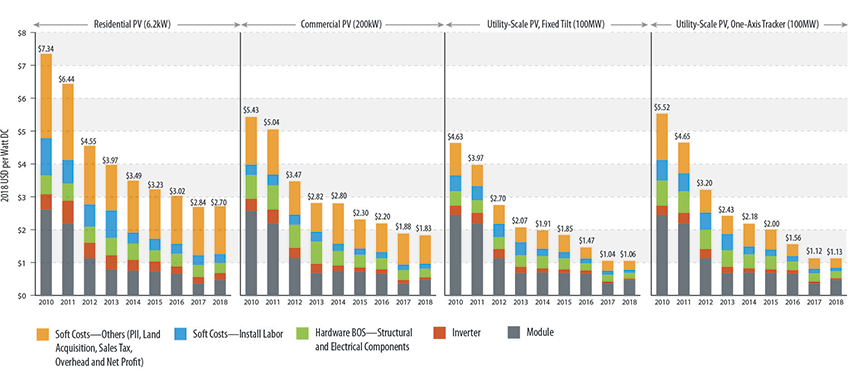Costs Continue to Decline for Residential and Commercial Photovoltaics in 2018
Two NREL Reports Track Evolving Costs of Standalone Photovoltaics and PV-Plus-Storage

NREL's 2018 cost benchmarks for installed PV systems found a continued decline in cost for residential- and commercial-scale systems, and a slight increase in cost for utility-scale systems. A similar report established NREL's first such cost benchmarks for PV-plus-storage systems.
Continuing an annual NREL cost benchmarking effort that began in 2010, “U.S. Solar Photovoltaic System Cost Benchmark: Q1 2018,” found installed costs of PV systems declined across two of three sectors in the first quarter of 2018 from a year earlier. The other report, “2018 U.S. Utility-Scale Photovoltaics-Plus-Energy Storage System Cost Benchmark,” establishes NREL’s first benchmark of PV-plus-storage costs.
Costs Fall for Residential and Commercial Standalone PV
Specifically, the Q1 PV cost benchmarks are $2.70 per watt of direct current (Wdc) for residential systems (a 4.9 percent cost decline), $1.83 per Wdc for commercial systems (a 2.6 percent decrease), $1.06 per Wdc for fixed-tilt utility-scale systems (a 1.9 percent increase), and $1.13 per Wdc for one-axis-tracking utility-scale systems (a 0.9 percent increase).
“Higher-voltage inverter designs, lower inverter prices, and higher module efficiencies contributed to cost reductions,” said Ran Fu, who authored the report with fellow NREL researchers David Feldman, Mike Woodhouse, and Robert Margolis. On the other hand, higher module prices, higher labor wages, and higher steel prices raised costs. In the utility sector, where PV modules represent a larger portion of overall project costs, increased module prices helped to drive the slight increase in installed solar costs.
New Benchmark Established for Battery Storage Costs
Fu and Margolis, along with fellow NREL researcher Timothy Remo, authored a companion report that provides NREL’s first cost benchmarking of energy storage and PV-plus-storage systems. The report, “2018 U.S. Utility-Scale Photovoltaics-Plus-Energy Storage System Cost Benchmark” models the costs of several standalone lithium-ion storage and PV-plus-storage system configurations.
For a standalone storage system, assuming a constant battery price of $209 per kilowatt-hour (kWh), the installed system costs vary from $380/kWh for a four-hour battery system to $895/kWh for a 30-minute battery system.
Historically, most PV-plus-storage systems have installed PV and storage systems in separate locations. However, the report finds that co-locating the PV and storage subsystems reduces costs related to site preparation, land acquisition, permitting, interconnection, labor, and hardware.
Both reports and their models can be used to estimate future cost-reduction opportunities for PV and PV-plus-storage systems, helping to guide research and track costs. These reports were funded by the U.S. Department of Energy Solar Energy Technologies Office.
Last Updated May 28, 2025
